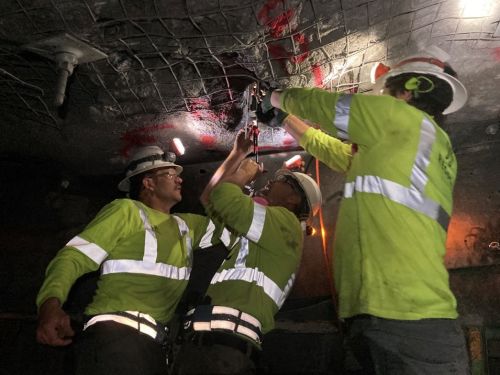A Deeper Look: Our Role in the Hole
by Michael Adams | Updated: 04/23/2024 | Comments: 0

Have you read the South Dakota: Rock Stability in Large Underground Excavation case study? It’s a short and interesting read, so check it out if you haven’t already. In this blog article, we’ll take a deeper look at Campbell Scientific’s role in a large-cavern, hard-rock excavation project at the Sanford Underground Research Facility (SURF).
As we strive for scientific advancement with an unwavering commitment to progress, we’d like to highlight the monitoring efforts undertaken during the blasting and construction phase of the SURF “4850 Level” project.
To ensure measurement accuracy, product reliability, and longevity throughout the expansion of the deepest underground laboratory in the United States, the contracted integrator, RESPEC, turned to Campbell Scientific's VSPECT® products. The RESPEC team chose these products to help oversee construction activities and uphold safety standards during this expansive endeavor.
Close monitoring of rock movements in critical areas was possible thanks to the implementation of 64 multi-point bore hole extensometers, spanning depths from 10.1 to 19.8 m (33 to 65 ft) for each bore hole. In addition, multiple-point inclinometers were strategically placed to assess the stability of various work zones, prioritizing the well-being of construction crew members while gathering valuable data for long-term stability analysis.
Operating within an active blasting and construction environment posed challenges, including high ambient electrical interference and random noise levels. However, with the Campbell Scientific CR6, CR1000X, and AVW200 equipped with patented VSPECT circuitry, we were able to maintain exceptional noise immunity for the project. This ensured accurate measurements, minimizing the risk of false alarms that could disrupt workflow or, worse, jeopardize worker safety in a potentially dangerous environment.
With proven, multi-decade reliability and measurement performance, the Campbell Scientific VSPECT devices will ensure the integrity of critical data points in an important underground research laboratory for years to come.
If you have any questions or comments, please post them below or reach out to our infrastructure team at CSI-Infrastructure@campbellsci.com. To learn more about VSPECT technology, visit our VSPECT Essentials resource page.















 Michael Adams is a Sales Engineer for the infrastructure and geotechnical markets at Campbell Scientific, Inc. He has a degree in Electronic Systems, which he has applied for more than 30 years in system design, field deployment, and system longevity/reliability—with a strong focus on instrumentation and field troubleshooting. When he's not working, Michael can be found cycling, skiing, or flyfishing.
Michael Adams is a Sales Engineer for the infrastructure and geotechnical markets at Campbell Scientific, Inc. He has a degree in Electronic Systems, which he has applied for more than 30 years in system design, field deployment, and system longevity/reliability—with a strong focus on instrumentation and field troubleshooting. When he's not working, Michael can be found cycling, skiing, or flyfishing.
Comments
J. Magnin | 02/15/2017 at 03:20 AM
Hello,
This article is quite useful, although your code has some mistakes: you use 2 variables names for the same object (stn.data / station.data & stn.info / station.info), so the function stops & returns an error.
By the way, the way you use scan & read.table gave me an idea for enhanced functions to read TOA5 data (and why not, later, other data formats ?). I would like to publish that work, as soon as it will be done, on the CRAN (maybe under GPL V3) to make it available for the R users community. For this, I would like to have your authorization for using your code as a basis, if you agree with that idea.
Thanks,
J.M.
Dirk | 02/15/2017 at 10:33 AM
Thank you for pointing that out, JM! Looks like I introduced that typo in condensing the code to fit the page. It's fixed now and a downloadable version added.
I like the idea of expanding and enhancing the function and, as far as I'm concerned, anyone is free to use and modify my code as needed. I'm interested to learn more about your ideas and possibly collaborating. You're welcome to contact me at dbaker@campbellsci.com.
Thanks!
Dirk
ariklee | 02/23/2018 at 12:57 PM
Awesome! Great to see R represented in a Campbell blog. I've written a short R script also to read TOA5 data, it's pretty handy to separate out the 4-line header from the data.
A quick search on Github shows a few repositories related to reading and plotting TOA5 Campbell data: https://github.com/search?l=R&q=campbell&type=Repositories&utf8=%E2%9C%93
Thanks for your contribution!
Eric
Bissett | 11/01/2022 at 08:26 PM
Hi Dirk,
I am trying to use this to combine station files with backup files, etc. The problem I am having is that the header prints out each line in quotes, and removes the quotes from around each character string and I am worried that will cause a problem when loggernet tries to write new data to the file.
Before import the header looks like:
"TOA5","CR300_1","CR300","5514","CR300-RF407.Std.10.06","CPU:CR300_1.CR300","41351","Hourly_met"
"TIMESTAMP","RECORD","Rain_mm_Tot","AirTC_Avg","RH","WS_ms_S_WVT","WindDir_D1_WVT","SlrW_Avg","ETos","Rso"
"TS","RN","mm","Deg C","%","meters/second","Deg","W/m^2","mm","MJ/m²"
"","","Tot","Avg","Smp","WVc","WVc","Avg","ETXs","Rso"
Exported version:
TOA5,CR300_1,CR300,5514,CR300-RF407.Std.10.06,CPU:CR300_1.CR300,41351,Hourly_met TIMESTAMP,RECORD,Rain_mm_Tot,AirTC_Avg,RH,WS_ms_S_WVT,WindDir_D1_WVT,SlrW_Avg,ETos,Rso TS,RN,mm,Deg C,%,meters/second,Deg,W/m^2,mm,MJ/m² ,,Tot,Avg,Smp,WVc,WVc,Avg,ETXs,Rso
If you could let me know if there is a solution, I would greatly appreciate it.
Thanks! Bissett
Dirk | 11/01/2022 at 10:02 PM
Hi Bissett,
The intent of this code is to import the data for the next steps of analysis and visualization, not to combine files into a format that LoggerNet would recognize. This is possible, but would take some additional work, as you've noted.
I'll send you and email shortly so we can talk more about possible solutions for what you want to do.
Best,
Dirk
Joseph Knudsen | 06/27/2023 at 06:46 PM
Hi Dirk,
What package includes the importCSdata() function? -Thanks!
Dirk | 06/28/2023 at 06:04 PM
Hi Joseph,
The function is included as a downloadable text file, so it can simply be run as part of a script or at the command prompt. It is not part of a package.
Best,
Dirk
data science | 05/25/2024 at 03:31 PM
how can i download data straight from online into r
Please log in or register to comment.